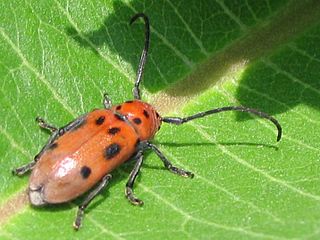Related Research Articles

The red milkweed beetle is a beetle in the family Cerambycidae.

The grey-crowned tanager or grey-crowned palm-tanager is a Near Threatened species of bird in the family Phaenicophilidae, the Hispaniolan tanagers. It is endemic to the Caribbean island of Hispaniola, in both the Dominican Republic and Haiti.
Davidaster discoideus or the beaded crinoid is a species of feather star in the family Comatulidae. It was previously known as Nemaster discoidea but the World Register of Marine Species has determined that the valid name is Davidaster discoideus. It is found on reefs in the Caribbean Sea and northern coast of South America.

Tetraopini is a tribe of longhorn beetles in the subfamily Lamiinae.
Acmaeops discoideus is a long-horned beetle in the flower longhorn subfamily, Lepturinae. It is found in the United States and Canada, and feeds on Virginia pine.

Tetraopes is a genus of longhorn beetles of the subfamily Lamiinae, tribe Tetraopini, containing the following species:
Tetraopes annulatus is a species of beetle in the family Cerambycidae. It was described by John Lawrence LeConte in 1847. It is known from the United States and Canada. Reported feeding on Asclepias sullivantii, A. subverticillata, A. speciosa, A. tuberosa, A. verticillata, A. viridiflorus.
Tetraopes umbonatus is a species of beetle in the family Cerambycidae. It was described by John Lawrence LeConte in 1852. It is known from Nicaragua and Mexico.
Tetraopes batesi is a species of beetle in the family Cerambycidae. It was described by Chemsak in 1963. It is known from Mexico.
Tetraopes linsleyi is a species of beetle in the family Cerambycidae. It was described by Chemsak in 1963. It is known from the United States.
Tetraopes cleroides is a species of beetle in the family Cerambycidae. It was described by James Thomson in 1860. It is known from Mexico.
Tetraopes submersus is an extinct species of beetle in the family Cerambycidae. It was described by Theodore Dru Alison Cockerell in 1908. It existed in what is now the United States.

Tetraopes texanus is a species of beetle in the family Cerambycidae. It was described by George Henry Horn in 1878. It is known from Mexico and the United States.
Tetraopes varicornis is a species of beetle in the family Cerambycidae. It was described by Laporte in 1840. It is known from Mexico.
Tetraopes thermophilus is a species of flat-faced longhorn in the beetle family Cerambycidae. It is found in Central America and North America.
Carpophilus discoideus is a species of sap-feeding beetle in the family Nitidulidae. It is found in North America.
Anisodactylus discoideus is a species of ground beetle in the family Carabidae. It is found in North America.
Smicronyx discoideus is a species of true weevil in the beetle family Curculionidae. It is found in North America.
Phyllobaenus discoideus is a species of checkered beetle in the family Cleridae. It is found in Central America and North America.
Leucocoprinus discoideus is a species of mushroom producing fungus in the family Agaricaceae. In the local language when the mushroom cap is open it is known as batakania or bepokua pembe when it is immature with a closed cap. However 'bepokua' may also be used to refer to other similar looking mushroom species such as Micropsalliota bambusicola.
References
- ↑ BioLib.cz - Tetraopes discoideus. Retrieved on 8 September 2014.